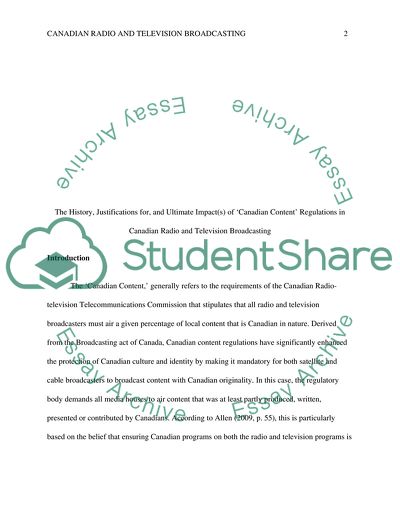Cite this document
(“Discuss the history and evolution, justifications for, and ultimate Essay - 1”, n.d.)
Discuss the history and evolution, justifications for, and ultimate Essay - 1. Retrieved from https://studentshare.org/journalism-communication/1666264-discuss-the-history-and-evolution-justifications-for-and-ultimate-impacts-of-canadian-content-regulations-in-canadian-radio-and-television-broadcasting-from-the-industrys-inception-to-the-present
Discuss the history and evolution, justifications for, and ultimate Essay - 1. Retrieved from https://studentshare.org/journalism-communication/1666264-discuss-the-history-and-evolution-justifications-for-and-ultimate-impacts-of-canadian-content-regulations-in-canadian-radio-and-television-broadcasting-from-the-industrys-inception-to-the-present
(Discuss the History and Evolution, Justifications For, and Ultimate Essay - 1)
Discuss the History and Evolution, Justifications For, and Ultimate Essay - 1. https://studentshare.org/journalism-communication/1666264-discuss-the-history-and-evolution-justifications-for-and-ultimate-impacts-of-canadian-content-regulations-in-canadian-radio-and-television-broadcasting-from-the-industrys-inception-to-the-present.
Discuss the History and Evolution, Justifications For, and Ultimate Essay - 1. https://studentshare.org/journalism-communication/1666264-discuss-the-history-and-evolution-justifications-for-and-ultimate-impacts-of-canadian-content-regulations-in-canadian-radio-and-television-broadcasting-from-the-industrys-inception-to-the-present.
“Discuss the History and Evolution, Justifications For, and Ultimate Essay - 1”, n.d. https://studentshare.org/journalism-communication/1666264-discuss-the-history-and-evolution-justifications-for-and-ultimate-impacts-of-canadian-content-regulations-in-canadian-radio-and-television-broadcasting-from-the-industrys-inception-to-the-present.


